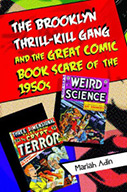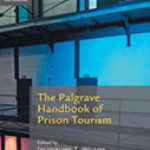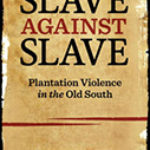The Brooklyn Thrill-Kill Gang and the Great Comic Book Scare of the 1950s

Author: Mariah Adin
Publisher: Santa Barbara, CA: Praeger, 2015. 167p.
Reviewer: Christopher J. Moloney | January 2016
The events detailed in historian and author Mariah Adin’s new book, The Brooklyn Thrill-Kill Gang and the Great Comic Book Scare of the 1950s, are likely unknown to most casual and academic readers.
Thrill-Kill Gang recounts the crime spree of a small group of white, middle class, mostly Jewish teenage boys from respectable homes. Over the course of one summer, the boys engaged in a series of increasingly threatening and violent assaults. Their victims were mostly drunkards and homeless men. Their activities, which they described as “bum hunts,” eventually culminated in the death of one homeless man, Willard Menter, after the boys forced him to jump into the East River.
The story of a gang’s actions (perhaps a stretch of the word gang…see page 92) at the heart of Thrill-Kill is, by itself, unremarkable and hardly unique, particularly in contemporary times. Thus, what makes Adin’s Thrill-Kill interesting, and potentially valuable as an academic work, isn’t so much what the boys did, but when they did it and the ensuing societal reaction their conduct caused.
Specifically, the author does a solid job showing how the so-called wholesome innocence of the 1950s coincided with post-World War II fears over the changing social structure and dynamics of American society, to produce an environment ripe for overreaction and fear-mongering regarding an isolated juvenile crime spree. As Adin makes clear, the actions of the Thrill-Kill Gang touched a raw societal nerve. People at the time could not fathom, as Adin notes, what could have led “respectable boys from religious, middle income homes” to become “cold-blooded killers.”
The befuddled response to the Thrill-Kill Gang’s behavior among members of the media, public and politicians was thus symptomatic of a more general inability to accept or understand juvenile delinquency in any form during the early and mid-1950s. To most people at that time, juvenile delinquency and serious juvenile crime were isolated to particular groups, particularly the poor, new immigrants and minorities. It was easy for middle and upper-class white Americans to ignore the behavior of these groups of “others,” writing it off as the product of one or more shortcomings (i.e., poverty, lack of education, broken homes, alcoholism, etc.). Furthermore, the bad behavior of juveniles from the lower rungs of society could also be isolated from mainstream society, figuratively and literally (i.e., geographically) as a phenomena that occurred “over there” in some distant place where most “decent” people did not venture.
Yet the Thrill-Kill Gang upset this tidy frame for making sense of juvenile crime. That gang was composed of white kids from good homes. They attended good schools, were fairly decent students and they had parents that cared about them. Making matters worse, these boys had not just engaged in some minor mischief — they had violently attacked innocent people on more than one occasion, for fun, and were directly responsible for a man’s death.
The contradiction produced by the discordance between the identities of the Thrill-Kill Gang’s members with existing notions of what kind of juveniles committed serious crimes created a dilemma that required resolution. People desired a firm answer for why or how this could have occurred. And, as Adin so deftly points out in the latter half of Thrill-Kill, they found their answer in the form of graphic and violent comic books.
Comic books, Adin argues, became public enemy no. 1—blamed for inciting impressionable, “respectable” young people, like the members of the Thrill Kill gang, to violence. The parallels here between 1950s comic books and 1990s video games are striking. Both forms became folk devils or scapegoats which society conveniently utilized to explain the same problem—serious violent crime committed by young people. Similarly, both comic books and video games provide(d) a neat and simple answer to a complex problem, allowing people to eschew digging deeper to look for the actual, and much more nuanced, causes of this problem.
I believe Adin’s Thrill Kill gang makes valuable contributions to multiple literatures: the sociology of societal reaction, moral panics, studies of juvenile delinquency, etc. It is, however, primarily a history book and often feels like it. In some places it drags and is bogged down by too much detail. To a sociologist or criminologist, it could stand more analysis and synthesis with other research literatures, particularly those dealing with social constructionism, moral panics, folk devils and so on.
In terms of applicability or usefulness in academic settings, I ultimately have mixed feelings. In general, I think the book is too heavy and too focused for general use in undergraduate courses where time is limited and reading loads are light, even though the book’s length is very manageable (only 167 pages including notes). It may perhaps be useful in some graduate courses that deal specifically with societal reaction, social policy formation or juvenile delinquency. Again, since Adin is a historian by training (and a good one) and the book is a history, I have no doubt it could find traction in that discipline’s courses; but since my expertise is not in that field, I can’t say for certain.
A more general concern of mine is if the subject—1950s juvenile crime—can hold the attention of today’s students. I found it interesting, but I am clearly not one of today’s average university undergraduates. Yes, the cover and title are arresting, but that flair does not exactly equate with what is between the covers. I feel students might think they are getting one thing based on the title and cover, begin reading past chapter 1, and lose interest as they encounter all of the historical details.
In sum, Thrill Kill gang is a good and useful read. Its greatest appeal will likely be amongst people like myself—academics or professionals curious to learn more about a case that had nearly been lost to time.


